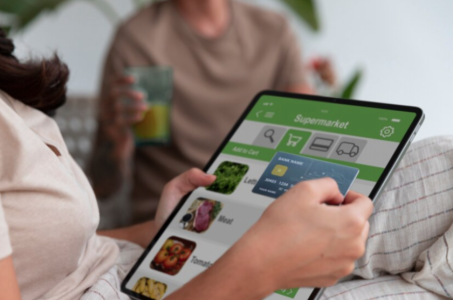Discover why more Australians are turning to online shopping amidst rising living costs
By
VanessaC
- Replies 7
Prices are constantly on the rise, and in such uncertain times, it’s no wonder so many of us are seeking better value for money.
And so amid the cost-of-living crisis comes the increasing trend of online shopping, just like the case of Sarah Woodland, an Aussie woman who stated that she’s one of the many who rely on online grocery services to do their weekly shopping.
'I can’t remember the last time I actually went to Woolworths,' Ms Woodland revealed.
She now does 90 per cent of her grocery shopping online as she found it to be more efficient and cheaper.
'My coworker actually got me on to Amazon and Amazon Prime. And just over time, I've just become more [dependent] on it,' she added.
'For example, I got some washing pods that were on sale for $6 the other day, and normally they would be like $13 or $14 in Woolworths.'
'I've actually got my mother onto that as well.'
Ms Woodland shared that she shops for fresh produce at Woolworths but sources everything else on her traditional grocery list from Amazon or eBay.
'I actually save time because I have a list of things I want, and I can get them delivered the next day,' she said.
'My most-bought item is cereal because it's always on sale at Amazon.'
'I've been able to save approximately $150 to $200 just by shopping at Amazon Prime and adjusting my shopping habits.'
This savvy shopper is also part of a growing group of Aussies who are looking around for the best deals.
'We know that Australian families are doing it tough,' said Retail Marketing Expert and Professor Gary Mortimer from QUT.
'And accordingly, they're shopping around across multiple brands and also multiple channels.'
'So they'll shop across multiple supermarkets each week or each fortnight in order to save money.'
Moreover, online grocery shopping is known to have peaked during the pandemic when everyone prioritised their own safety and avoided leaving their homes.
'We've seen a steady decline in online food and grocery shopping, [and] a swing back to physical retail shopping,' Professor Mortimer added.
'At the peak of COVID, we were spending about $4.4 billion every month online.'
'That's shifted back to somewhere between $3.6 to $3.7 billion every month, with about $800 million going back into physical retail stores.'
However, the fact of its four-fold growth remains.
'It [online shopping] used to be only about 1 or 2 per cent of retail sales for supermarkets—now it's close to 8 to 12 per cent.'
He acknowledged the benefits of online shopping and shopping around, however, it also came with its own trade-offs.
'One is time cost, so how much time you are prepared to invest in shopping around…the other one is fuel costs, and of course, delivery fees,' he said.
'If you're buying from multiple retailers, particularly online, and you're wearing delivery fees for each transaction, those savings can be lost pretty quickly.'
He suggested that shoppers evaluate their personal circumstances and see which option offers the best deal fit for their own situation.
Moreover, despite the return of people shopping in stores, the pandemic was proven to have changed shopping habits.
A recent UBS report found that the number of people who have turned to online retailers such as Catch of the Day and Amazon for their grocery shop has increased.
Though the two major supermarkets—Coles and Woolworths—still have the lion’s share of the market, their numbers have fallen as shoppers in IGA have increased.
Amazon, since the start of the pandemic, has also reportedly seen the growth of their numbers when it came to everyday household product sales and other non-perishable items.
The pandemic saw a huge surge in online grocery shopping as people had to stay home for safety measures. It has since dropped to a slightly lower level but is still much higher than before, showing that online grocery shopping is here to stay.
'Customers tell us that before COVID-19, they might not have thought about shopping online but because of the experience they had during COVID, they’ve stayed online,' said Amazon Australia Country Manager Janet Menzies.
'If there's anything you go through reliably in two to four weeks, those are the products that get the most take-up.'
'It's toilet paper, it's tissues, it's dishwasher tablets, it's beverages.'
During the high cost of living crisis, Ms Menzies acknowledged that people have started taking their time to compare products to ensure they will get the most value for their money.
In recent news, ALDI is reportedly joining the online shopping space as the supermarket acknowledged that resisting the allure of e-commerce in a bid to maintain low grocery costs might no longer be sustainable.
They've realised that if they continue to resist, they risk losing loyal customers to their competitors who offer online buying.
Adrian Christie, ALDI’s Director of Customer Interactions, expressed this significant strategic shift at a recent parliamentary inquiry. In response to questions about the supermarket competition, he stated confidently: 'You will see us entering that space in the future.'
'There is a significant share moving into the online space. It's something we're watching very carefully.'
However, the service may not be launched anytime soon.
'While we are always looking at the environment and considering an online experience, we won't bring this forward until we have a model where associated overheads of e-commerce in no way compromises our ability to deliver low-priced groceries to Australians,' Mr Christie assured.
The challenge for ALDI now lies in finding the perfect balance of trying to offer the convenience of online shopping while still maintaining prices that are 15-20 per cent lower than their competition—a core offer for ALDI in Australia.
Many of our members are thrilled with this news with member @loubart saying: 'Have been shopping with supermarket since [the] beginning. Will definitely swap to ALDI online.'
'Yes definitely keen to check this out if they do deliveries!' member @Cheezil added.
While some members prefer to do their shopping in-store with member @Trudi saying: 'I have no interest in doing my grocery shopping online.'
And member @0417128714 added: 'Personally, l never use online anything. In my opinion, doing shopping is a social outing that is planned in advance and keeps me active and keeps my brain sharp by mentally adding up the prices as l add to the cart. I also pay in cash so l keep track of change the teller gives me.'
 Members, have you tried shopping for essential items online? How was the experience? Let us know in the comments below!
Members, have you tried shopping for essential items online? How was the experience? Let us know in the comments below!
And so amid the cost-of-living crisis comes the increasing trend of online shopping, just like the case of Sarah Woodland, an Aussie woman who stated that she’s one of the many who rely on online grocery services to do their weekly shopping.
'I can’t remember the last time I actually went to Woolworths,' Ms Woodland revealed.
She now does 90 per cent of her grocery shopping online as she found it to be more efficient and cheaper.
'My coworker actually got me on to Amazon and Amazon Prime. And just over time, I've just become more [dependent] on it,' she added.
'For example, I got some washing pods that were on sale for $6 the other day, and normally they would be like $13 or $14 in Woolworths.'
'I've actually got my mother onto that as well.'
Ms Woodland shared that she shops for fresh produce at Woolworths but sources everything else on her traditional grocery list from Amazon or eBay.
'I actually save time because I have a list of things I want, and I can get them delivered the next day,' she said.
'My most-bought item is cereal because it's always on sale at Amazon.'
'I've been able to save approximately $150 to $200 just by shopping at Amazon Prime and adjusting my shopping habits.'
This savvy shopper is also part of a growing group of Aussies who are looking around for the best deals.
'We know that Australian families are doing it tough,' said Retail Marketing Expert and Professor Gary Mortimer from QUT.
'And accordingly, they're shopping around across multiple brands and also multiple channels.'
'So they'll shop across multiple supermarkets each week or each fortnight in order to save money.'
Moreover, online grocery shopping is known to have peaked during the pandemic when everyone prioritised their own safety and avoided leaving their homes.
'We've seen a steady decline in online food and grocery shopping, [and] a swing back to physical retail shopping,' Professor Mortimer added.
'At the peak of COVID, we were spending about $4.4 billion every month online.'
'That's shifted back to somewhere between $3.6 to $3.7 billion every month, with about $800 million going back into physical retail stores.'
However, the fact of its four-fold growth remains.
'It [online shopping] used to be only about 1 or 2 per cent of retail sales for supermarkets—now it's close to 8 to 12 per cent.'
He acknowledged the benefits of online shopping and shopping around, however, it also came with its own trade-offs.
'One is time cost, so how much time you are prepared to invest in shopping around…the other one is fuel costs, and of course, delivery fees,' he said.
'If you're buying from multiple retailers, particularly online, and you're wearing delivery fees for each transaction, those savings can be lost pretty quickly.'
He suggested that shoppers evaluate their personal circumstances and see which option offers the best deal fit for their own situation.
Moreover, despite the return of people shopping in stores, the pandemic was proven to have changed shopping habits.
A recent UBS report found that the number of people who have turned to online retailers such as Catch of the Day and Amazon for their grocery shop has increased.
Though the two major supermarkets—Coles and Woolworths—still have the lion’s share of the market, their numbers have fallen as shoppers in IGA have increased.
Amazon, since the start of the pandemic, has also reportedly seen the growth of their numbers when it came to everyday household product sales and other non-perishable items.
The pandemic saw a huge surge in online grocery shopping as people had to stay home for safety measures. It has since dropped to a slightly lower level but is still much higher than before, showing that online grocery shopping is here to stay.
'Customers tell us that before COVID-19, they might not have thought about shopping online but because of the experience they had during COVID, they’ve stayed online,' said Amazon Australia Country Manager Janet Menzies.
'If there's anything you go through reliably in two to four weeks, those are the products that get the most take-up.'
'It's toilet paper, it's tissues, it's dishwasher tablets, it's beverages.'
During the high cost of living crisis, Ms Menzies acknowledged that people have started taking their time to compare products to ensure they will get the most value for their money.
In recent news, ALDI is reportedly joining the online shopping space as the supermarket acknowledged that resisting the allure of e-commerce in a bid to maintain low grocery costs might no longer be sustainable.
They've realised that if they continue to resist, they risk losing loyal customers to their competitors who offer online buying.
Adrian Christie, ALDI’s Director of Customer Interactions, expressed this significant strategic shift at a recent parliamentary inquiry. In response to questions about the supermarket competition, he stated confidently: 'You will see us entering that space in the future.'
'There is a significant share moving into the online space. It's something we're watching very carefully.'
However, the service may not be launched anytime soon.
'While we are always looking at the environment and considering an online experience, we won't bring this forward until we have a model where associated overheads of e-commerce in no way compromises our ability to deliver low-priced groceries to Australians,' Mr Christie assured.
The challenge for ALDI now lies in finding the perfect balance of trying to offer the convenience of online shopping while still maintaining prices that are 15-20 per cent lower than their competition—a core offer for ALDI in Australia.
Many of our members are thrilled with this news with member @loubart saying: 'Have been shopping with supermarket since [the] beginning. Will definitely swap to ALDI online.'
'Yes definitely keen to check this out if they do deliveries!' member @Cheezil added.
While some members prefer to do their shopping in-store with member @Trudi saying: 'I have no interest in doing my grocery shopping online.'
And member @0417128714 added: 'Personally, l never use online anything. In my opinion, doing shopping is a social outing that is planned in advance and keeps me active and keeps my brain sharp by mentally adding up the prices as l add to the cart. I also pay in cash so l keep track of change the teller gives me.'
Key Takeaways
- Many Australians have turned to doing their grocery shopping online, with platforms such as Amazon and eBay seeing an increase in growth.
- Although a return to physical stores has been noted post-pandemic, online grocery shopping remains high, with it now constituting between 8 and 12 per cent of all supermarket sales.
- Amazon Australia's Country Manager, Janet Menzies, has reported an increase in purchases of everyday household products.
- Low-cost supermarket ALDI is considering opportunities to offer online shopping in the future, according to Adrian Christie, ALDI Australia's Director of Customer Interactions, speaking at a parliamentary inquiry.








